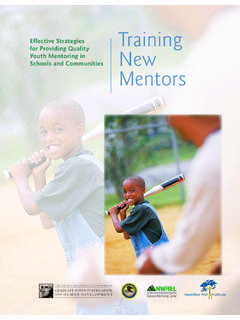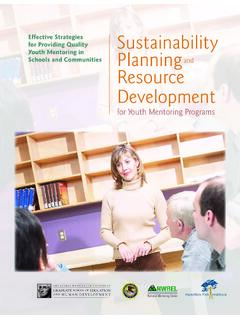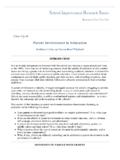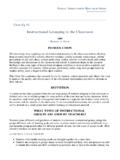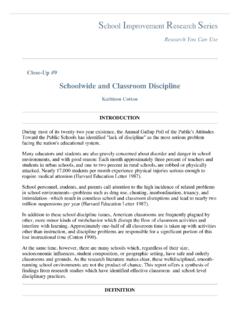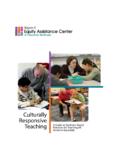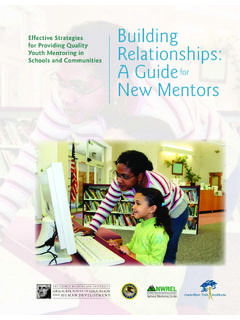Transcription of Foundations of Successful Youth Mentoring
1 Effective Strategies Foundations of for Providing Quality Youth Mentoring in Schools and Communities Successful Youth Mentoring National Mentoring Center This publication contains pages that have been left intentionally blank for proper pagination when printing. Foundations of Successful Effective Strategies for Providing Quality Youth Mentoring Youth Mentoring in Schools and Communities A Guidebook for Program Development Revised September 2007. Published by: The Hamilton Fish Institute on School and Community Violence &. The National Mentoring Center at Northwest Regional Educational Laboratory With support from: Office of Juvenile Justice and Delinquency Prevention, Department of Justice Hamilton Fish Institute on School and Community Violence The George Washington University 2121 K Street NW, Suite 200, Washington, DC 20037-1830. Ph: (202) 496-2200. E-mail: Web site: Hamilton Fish Institute Director: Dr. Beverly Caffee Glenn National Mentoring Center Northwest Regional Educational Laboratory 101 SW Main St.
2 , Suite 500, Portland, OR 97204. Toll-free number: 1-800-547-6339, ext. 135. E-mail: Web: National Mentoring Center Director: Eve McDermott Contributing Authors: Michael Garringer and Patti MacRae Edited by: Michael Garringer and Patti MacRae Technical editor: Eugenia Cooper Potter Layout design: Dennis Wakeland Cover design: Paula Surmann 2008, National Mentoring Center All Rights Reserved This project was supported by the Hamilton Fish Institute on School and Community Violence through Award No. 2005-JL-FX-0157 awarded by the Office of Juvenile Justice and Delinquency Prevention, Office of Justice programs , Department of Justice. Points of view or opinions in this document are those of the author and do not necessarily represent the official position or policies of the Department of Justice or the Hamilton Fish Institute. About the Effective Strategies for Providing Quality Youth Mentoring in Schools and Communities Series Mentoring is an increasingly popular way of providing guidance and support to young people in need.
3 Recent years have seen Youth Mentoring expand from a relatively small Youth intervention (usually for Youth from single-parent homes) to a cornerstone Youth service that is being implemented in schools, community centers, faith institutions, school-to-work programs , and a wide variety of other Youth -serving institutions. While almost any child can benefit from the magic of Mentoring , those who design and implement Mentoring programs also need guidance and support. Running an effective Mentoring program is not easy, and there are many nuances and programmatic details that can have a big impact on outcomes for Youth . Recent Mentoring research even indicates that a short-lived, less-than-positive Mentoring relationship (a hallmark of programs that are not well designed) can actually have a negative impact on participating Youth . Mentoring is very much worth doing, but it is imperative that programs imple- ment proven, research-based best practices if they are to achieve their desired outcomes.
4 That's where this series of publications can help. The Effective Strategies for Providing Quality Youth Mentoring in Schools and Communities series, sponsored by the Hamilton Fish Institute on School and Community Violence, is designed to give practitioners a set of tools and ideas that they can use to build qual- ity Mentoring programs . Each title in the series is based on research (primarily from the esteemed Public/Private Ventures) and observed best practices from the field of Mentoring , resulting in a collection of proven strategies, techniques, and program structures. Revised and updated by the National Mentoring Center at the Northwest Regional Educational Laboratory, each book in this series provides insight into a critical area of mentor program development: Foundations of Successful Youth Mentoring This title offers a compre- hensive overview of the characteristics of Successful Youth Mentoring programs .
5 Originally designed for a community-based model, its advice and planning tools can be adapted for use in other settings. iii generic Mentoring Program policy and Procedure manual Much of the success of a Mentoring program is dependent on the structure and consistency of service delivery, and this guide provides advice and a customizable template for creating an operations manual for a local Mentoring program. Training New Mentors All mentors need thorough training if they are to possess the skills, attitudes, and activity ideas needed to effectively mentor a young person. This guide provides ready-to-use training modules for your program. The ABCs of School-Based Mentoring This guide explores the nu- ances of building a program in a school setting. Building Relationships: A Guide for New Mentors This resource is written directly for mentors, providing them with 10 simple rules for being a Successful mentor and quotes from actual volunteers and Youth on what they have learned from the Mentoring experience.
6 Sustainability Planning and Resource Development for Youth Mentoring programs Mentoring programs must plan effectively for their sustainability if they are to provide services for the long run in their community. This guide explores key planning and fundraising strate- gies specifically for Youth Mentoring programs . The Hamilton Fish Institute and the National Mentoring Center hope that the guides in this series help you and your program's stakehold- ers design effective, sustainable Mentoring services that can bring positive direction and change to the young people you serve. iv Acknowledgments The original version of this publication was developed under a coop- erative agreement with the Office of Juvenile Justice and Delinquency Prevention (OJJDP). The National Mentoring Center (NMC) would like to thank the OJJDP for its continued support for the devel- opment of resources and tools that benefit Mentoring programs nationwide.
7 The NMC would also like to thank our original partner agencies Big Brothers Big Sisters of America (BBBSA), Public/Private Ventures (P/PV), and Information Technology International (ITI) for their criti- cal insights into Mentoring program development. We also thank the following individuals who participated in the conceptual devel- opment of this publication: Joyce Corlett, Janet Forbush, Mark Fulop, Carla Herrera, Rene Hoover, Jodi Jaworski, Jayme Marshall, Elizabeth Mertinko, Larry Novotney, John Patterson, Vikki Rennick, Christian Rummell, and Dr. Susan Weinberger. The NMC also thanks Scott Peterson at the Office of Juvenile Justice and Delinquency Prevention, Department of Justice for his sup- port of the NMC and for Mentoring in general. Finally, we thank the Hamilton Fish Institute on School and Community Violence at The George Washington University for their support in developing and disseminating this revised publication.
8 V Blank page Contents Introduction .. 1. How To Use This Guidebook .. 2. Moving Forward .. 2. Section 1. Preparing To Start a New Program .. 3. Find Your Niche: Assessing the Need for Mentoring in Your Community ..3. Create (or Get Support From) a Board or Advisory Committee ..8. Cultivate a Strong Knowledge of Mentoring and Youth Development Research ..9. Develop a Mission Statement, a Vision, and a Logic Model .. 10. Develop Partnerships To Deliver Services Effectively .. 12. Plan Implementation Carefully .. 16. Section II. Designing Mentoring Services .. 19. Volunteer Recruitment .. 19. Initial Orientation of Prospective Mentors and Mentees.. 26. Mentor/Mentee Intake .. 27. Mentor Screening .. 29. Making Matches .. 46. Monitoring Matches .. 48. Match Closure .. 54. Program Evaluation .. 57. Section III. Sustaining the Program Through Increased Organizational Capacity .. 63. Develop a Written policy and Procedure manual .
9 63. Implement a Resource Development Plan .. 65. Develop a Qualified and Stable Staff.. 72. Use Training and Technical Assistance Services .. 74. Increase Community Awareness of the Program .. 76. Use Evaluation Data for Program Enhancement .. 82. Collaborate With Other Local Youth -Serving Organizations.. 84. References .. 87. Appendix .. 89. Checklist of Program Progress.. 91. Timeline for New Mentoring programs .. 97. Recommended Reading .. 99. vii Blank page Introduction About This Guidebook T here is a great deal of variety in the design and structure of Youth Mentoring programs across the United States. Every program is unique in some way and faces its own circumstances. But there are some common characteristics that suc- cessful adult- Youth Mentoring programs share. This guide is intended to provide a generic pro- gram model based on current research that can be adapted and implemented in a variety of settings.
10 Citations of specific research findings have been included in this guide where appropriate, but there are several key pieces of literature on Youth Rhodes, (2002). Stand by me: The risks Mentoring that contributed greatly to the overall and rewards of Mentoring today's Youth . program advice and structure promoted here: Cambridge, MA: Harvard University Press. Rhodes, , & Dubois, (2006). DuBois, , Holloway, , Valentine, Understanding and facilitating the Youth , & Cooper, H. (2002). Effectiveness of Mentoring movement. Social policy Report, Mentoring programs for Youth : A meta- 20(3). analytic review. American Journal of Com- munity Psychology, 30(2), 157 197. Tierney, J., & Grossman, , (with Resch, ). (2000). Making a difference: An Dubois, , & Karcher, (Eds.). (2005). impact study of Big Brothers/Big Sisters. Handbook of Youth Mentoring . Thousand (Reissued ed.). Philadelphia, PA: Public/. Oaks, CA: Sage. Private Ventures.
